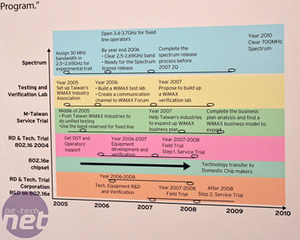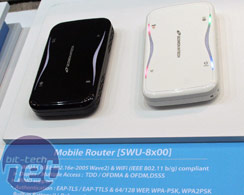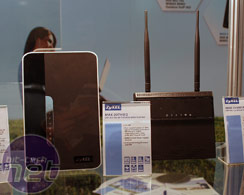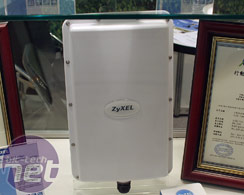WiMAX takes off, but we'll never use it
We hear the odd snippet of news about WiMAX in the UK - most of which is directly from Intel, which is unsurprising give that it's a producer of WiMAX chips and keen industrial backer of the technology - however it still mostly remains theoretical. Most of us have no idea about when we'll ever see it in the real world, or if we ever will.Having seen that the WiMAX Forum Congress 2010 was in town here in Taipei, we popped down for a chat with local Telecoms companies and hardware manufacturers about how they saw WiMAX was developing, and importantly - if we'd ever see it over in Europe and the US.
We're using more and more web-enabled products with 3G/3.5G(HSDPA) installed for browsing the web when there's no WiFi - it's not just phones these days - and WiMAX (an acronym for Worldwide Interoperability for Microwave Access) is a faster method of data transfer for mobile devices.
So, why do we need WiMAX? Well, first of all WiMAX is faster than 3G and HSDPA - currently offering 30Mbit/s transfers, versus the 7.2Mbit/s for HSDPA. As ever, these are theoretical “marketable” values – in real terms you’ll get 15Mbit/s for WiMAX and 3-4Mbit/s in HSDPA according to the techies I spoke to. Secondly, WiMAX is a dedicated data network, unlike 3G networks, where data has to share the airwaves with voice and messaging services. Telecom's companies prioritise the voice connections to minimise lag and also because they make more money from these aspects of the service - those "unlimited" data packages you see with your iPhone or Android device are typically passed through the network at a lower priority.
Engineers at the conference explained that comparatively WiMAX is designed for a better and more consistent connection speed because it has a wider band to play with and it all has one priority. The only slowdown naturally comes with capacity. There was a variety of WiMAX hardware available at the show to cater for the complete range of personal and business needs:
From the left, we have a mobile emitter that receives a WiMAX signal and converts it into a WiFi hotspot that any notebook, PC or mobile computing product such as an iPod Touch or mobile phone can use. The internal antenna is good for receiving a WiMAX signal around ~500M from the source. This is not far at all, but in a city with WiMAX coverage there should technically have regular emitters. In the centre are two Zyxel WiMAX routers - with an internal and external antenna, respectively they can receive signals 1-1.5km and 3-5km directly from the WiMAX base. Finally there's the big white base station which can be placed on the outside of a building and receive a WiMAX signal at up to 10km from its source.
The quoted figures are in a direct line of sight to the source, but through walls and buildings it drops off like any wireless signal does. There are a few advantages WiMAX has over DSL though - the first of which is that you're not tied to placing the modem within an arm’s length of the phone line, so the receiver can be in the roof or wherever you want, out the way, giving more freedom of choice.
Secondly, we were told it was actually cheaper than DSL because no connection fee and circuit infrastructure was required - assuming there is none of the cabling installed in the first place. After years of demanding and being ignored about the issue of naked DSL in the UK - investment in WiMAX in Britain could theoretically see more pressure on BT to reduce or drop its requirement for a monthly connection charge, even though many of us never use the actual landline phone (we'll actually be looking at the UK's broadband infrastructure in a forthcoming feature).
Unfortunately for WiMAX though, it requires a separate infrastructure to 3G networks and thus, separate investment - and that is the biggest sticking point.


WiMAX has currently been rolled out across Taiwan, however the country is split between separate operators in the north and south
Of the many hardware companies we talked to, unanimously they told us that developing or developed countries have already seen WiMAX rolled out in a big way. Several South American and Asian countries - the latter were specified as Japan, South Korea, Malaysia and Taiwan - have committed themselves to and in some cases, installed WiMAX networks. We were curious to know why India was not mentioned, given it has more mobile phones than landline connections, surely making it perfect for WiMAX. The answer, inevitably, was money. The average salary in India is very low (although rising), so while mobile phones and calls are cheap, fewer people own notebooks or use mobile internet and can afford a WiMAX contract, even if that doesn't correlate to "few" Indian people using the internet.
So what about Europe and the US? We were told that central US and Eastern Europe - where the population density is lower - are currently the target markets for WiMAX hardware companies right now. It was explained that due to the well-established "closed markets" we'll likely never see large scale WiMAX rollout in already developed Western countries, despite its advantages. This is for several reasons; it was claimed that losing the potential of making tasty profits from talk-time packages instead of giving customers a data free-for-all to allow alternative services like VoIP is not something Telecoms companies would accept. Also, current WiMAX rates are charged on speed of access, with 4M/2M (up and down) being the current standard in Taiwan, but in the future as speeds become faster and prices drop, the amount of return for "fast enough" packages will decrease, leading one sales rep we spoke to suggest that traffic priority might become an option: you could pay for your packets to get through first.
We've previously written about WiMAX in the UK on a few occasions in the past, although its publicity in 2010 is essentially non-existent for a modern technology. Apparently this is the kind of coverage we can expect - some might argue it looks like O2's 3G network - which could work fine for static business' within the few dots, it's not exactly coverage you could use to roll around the country with.
But what about if you do live in a WiMAX enabled area or frequently travel to one? Well there are some cool gagdets and hardware bits you should be aware of...

MSI MPG Velox 100R Chassis Review
October 14 2021 | 15:04












Want to comment? Please log in.